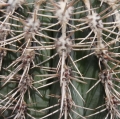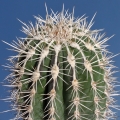




Your support is critical to our success.
Accepted Scientific Name: Pachycereus pringlei (S.Watson) Britton & Rose
Contr. U.S. Natl. Herb. 12: 422. 1909
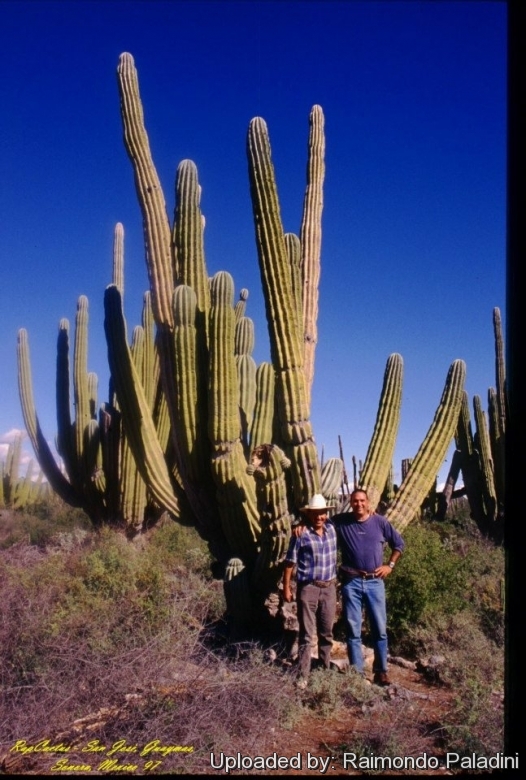
The Cardón Gigante, Pachyrereus pringlei at San Josè, Guaiamas, Sonora, mexico. It may lives to more than 200 years and may be the largest cactus in the world.
Origin and Habitat: Sonoran Desert of Sonora, Baja California, and Baja California Sur, Mexico. Pachyeereus Pringlei occurs almost throughout the desert areas of Baja California and near the coast in central Sonora. In Sonora it is abundant in a coastal belt about 50 km wide.
Altitude: From coast to coast in every area that has been visited below an elevation of about 700 m.
Habitat: Throughout most of the range it occurs as isolated individuals or in very open stands associated with many other plants. Like those of Carnegiea, its heaviest stands are on coarse outwash slopes and low hills, but it is much more tolerant of sand and alluvial soil than is Carnegiea. The most magnificent specimens are found in the bottoms of protected canyons. In exposed places and near the sea coast the plants are much smaller. Pachyrereus Pringlei can also occur on islands in a remarkably short and almost trunkless form that is a dramatic contrast to the usual tall peninsular forms that branch above ground.
Synonyms:
- Pachycereus pringlei (S.Watson) Britton & Rose
- Cereus pringlei S.Watson
- Pilocereus pringlei (S.Watson) F.A.C.Weber in Bois
Pachycereus pringlei (S.Watson) Britton & Rose
Contr. U.S. Natl. Herb. 12: 422. 1909
Synonymy: 5
- Pachycereus pringlei (S.Watson) Britton & Rose
- Cereus pringlei S.Watson
- Pilocereus pringlei (S.Watson) F.A.C.Weber in Bois
- Pachycereus titan (Engelm. ex J.M.Coult.) Britton & Rose
- Cereus titan Engelm. ex J.M.Coult.
Pachycereus pringlei f. calvus (Engelm. ex J.M.Coult.) P.V.Heath
Calyx 2(3): 107 (1992)
Synonymy: 4
- Pachycereus pringlei f. calvus (Engelm. ex J.M.Coult.) P.V.Heath
- Cereus calvus Engelm. ex J.M.Coult.
- Cereus pringlei var. calvus (Engelm. ex J.M.Coult.) M.E.Jones
- Pachycereus calvus Britton & Rose
Pachycereus pringlei f. constrictus P.V.Heath
Calyx 2(3): 107 (1992). Distribution: Locality not stated.
Accepted name in llifle Database:
Pachycereus pringlei f. cristatus P.V.Heath
Calyx 2(3): 107 (1992). Distribution: Locality not stated.
Accepted name in llifle Database:
Pachycereus pringlei f. gibbosus P.V.Heath
Calyx Calyx 2(3): 107 (1992). Locality not stated.
ENGLISH: Mexican Giant Cactus, Elephant Cactus
SERI (Cmiique iitom): Xaasj
SPANISH (Español): Sahuaso, Sagueso, Cardón Pelón, Cardón Gigante, Cardón, Senita
Description: The Cardón Gigante, Pachyrereus pringlei, is one of a well-known group of spectacular columnar cacti from the Sonoran Desert that includes the saguaro (Carnegiea giganteaSN|6374]]SN|6374]]), the organ-pipe cactus (Stenocereus thurberiSN|8265]]SN|8265]]) and senita (Lophocereus schottiiSN|8344]]SN|8344]]) which are famous because of their immense size and unique architecture. The Cardón Gigante occasionally reaching almost 20 m in height and 5 m spread, with a trunk diameter of 2 metres and a weigh of several tons. It may lives to more than 200 years and may be the largest cactus in the world.
Habit: Plants treelike, columnar, branched from near the base to 2-3 m above ground. Young plants of Pachyrereus Pringlei are slender at the base for many years, but increase greatly in thickness after formation of branches begins. In favourable situations the plants often reach a height of 10-12 m and produce from 5 or 6 to as many as 30 branches. It is only rarely that the Pachyrereus Pringlei retains an upright posture with all its branches in erect position. They usually give the impression of having been vigorously battered by the wind and thrown out of balance by their great weight.
Root: The root systems is relatively shallow but extend laterally for distances of 20 meters or more. A symbiotic relationship with bacterial and fungal colonies on its roots allows Pachicereus pringlei to grow on bare rock even where there is no soil available at all, as the bacteria can fix nitrogen from the air and break down the rock to produce nutrients. The cactus even packages symbiotic bacteria in with its seeds.
Trunk: Erect, well-formed to 60 cm in diameter, enlarged at the base and vividly suggesting the leg of an elephant. On the trunks of old trees, a smooth grey bark replaces the green surface and there is little or no indication of the ribs, which have been flattened by the secondary thickening.
Stems (branches): Strongly fluted, blue-green to dark green, becoming yellow-green,
20-40 cm in diameter. Higher on the old plants a rough bark is formed on the branches too, gradually extending down from the tops of the ribs.
Ribs: 10-16, at first deep, but become more shallow with increasing age. The glaucous green of the surface is marked by faint dark lines which run from the bottom of the groove to the apex of the ridge. The accordion-like vertical ribs enable Pachycereus stems to expand as moisture is absorbed and to contract as it is used, moreove they helps to scatter solar radiation.
Areoles: In young plants the ribs are capped by a close-set series of areoles with white glochids.
Central spines: 1-3, greyish white with darker tips, to 3 cm long.
Radial spines: 7-10, whitish to greyish-black, to 2 cm long. Flowering areoles large, terminal, covered with brown felt, connected by furrows or confluent.
Flowers: Arising from the areoles just below the apex of the stem down to 30 or 40 cm from the apex, opening both at night and during the day, funnelform to bell shaped, white, to 8 cm long; pericarpels and floral tubes bearing small scales with masses of brown hairs arising from their axils.
Blooming season: Spring ( late March or early April).
Fruits: globose, somewhat dry at maturity, to 7 cm long, covered with yellowish brown felt and bristle and contains about 500 very small seeds, a large number of which are abortive.
Renmarks: Pachyrereus pringlei and saguaro (Carnegiea giganteaSN|6374]]SN|6374]]), the two largest cacti in the Sonoran Desert, often occur together in western Sonora, but the two can be readily distinguished at a distance. Pachyrereus pringlei is a stouter, more massive plant that branches closer to the ground and the branches are inserted at a sharp angle rather than a sweeping curve. Saguaros has more numerous (19-25) vertical ribs and generally initiate branches higher off the ground and the mature stems are green rather than glaucous. The features of germination and growth are much like those in Carnegiea so far as is known and the young plants may be difficult to distinguish.
Subspecies, varieties, forms and cultivars of plants belonging to the Pachycereus pringlei group
 Pachycereus pringlei (S.Watson) Britton & Rose
Pachycereus pringlei (S.Watson) Britton & Rose Pachycereus pringlei f. cristatus P.V.Heath
Pachycereus pringlei f. cristatus P.V.Heath
Bibliography: Major references and further lectures:
1) Edward Anderson “The Cactus family” Timber Press, Incorporated, 2001
2) James Cullen, Sabina G. Knees, H. Suzanne Cubey "The European Garden Flora Flowering Plants: A Manual for the Identification of Plants Cultivated in Europe, Both Out-of-Doors and Under Glass" Cambridge University Press, 11/Aug/2011
3) David R Hunt; Nigel P Taylor; Graham Charles; International Cactaceae Systematics Group. "The New Cactus Lexicon" dh books, 2006
4) Felger, Richard; Mary B. Moser. “People of the desert and sea: ethnobotany of the Seri Indians.” Tucson: University of Arizona Press.1985
5) Urs Eggli, Leonard E. Newton: “Etymological Dictionary of Succulent Plant Names” Springer, Berlin/Heidelberg 2010
6) N. L. Britton, J. N. Rose: “The Cactaceae. Descriptions and Illustrations of Plants of the Cactus Family.” Volume II, The Carnegie Institution of Washington, Washington 1920
7) Forrest Shreve, Ira Loren Wiggins “Vegetation and Flora of the Sonoran Desert” Volume 1 and 2 Stanford University Press, 1964
8) H. Helia Bravo “Las Cactáceas de México” Universidad Nacional de México, 1937
9) Brian Lamb “Guide to cacti of the world” New York, Angus and Robertson (HarperCollins). Nobel, P. S. 17/Oct/1991
10) Puente, M. E.; Y. Bashan, C. Y. Li, and V. K. Lebsky "Microbial populations and activities in the rhizoplane of rock-weathering desert plants. I. Root colonization and weathering of igneous rocks". Plant Biology (Stuttgart) 6 (5): 629–42. (September 2004)
11) Puente, M. E.; C. Y. Li, and Y. Bashan (September 2004). "Microbial populations and activities in the rhizoplane of rock-weathering desert plants. II. Growth promotion of cactus seedlings" Plant Biology (Stuttgart) 6 (5): 643–50. (September 2004)
12) Del Weniger “Cacti of the Southwest: Texas, New Mexico, Oklahoma, Arkansas, and Louisiana” Austin: University of Texas Press. 1969
13) Michael A. Mares, Oklahoma Museum of Natural History (Norman, Oklahoma) “Encyclopedia of Deserts” University of Oklahoma Press, 1999
14) Ted J. Martin, L. Cody, Exequiel Ezcurra. “A New Island Biogeography of the Sea of Cortes” Oxford University Press, 23/Oct/2002
15) Edmund Carroll Jaeger “The North American Deserts” Stanford University Press, 1957
16) Jeff Nugent “Agaves and Cacti” permacultureplants, 1999
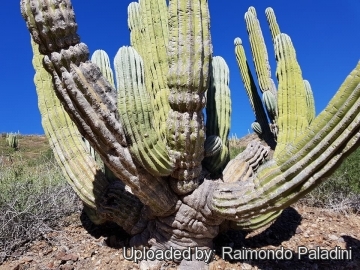
Pilocereus pringlei (Pachycereus pringlei) Photo by: Raimondo Paladini
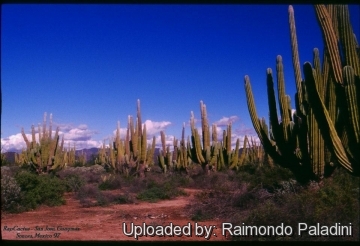
San Josè, Guaiamas, Sonora, mexico. (Pachycereus pringlei) Photo by: Raimondo Paladini
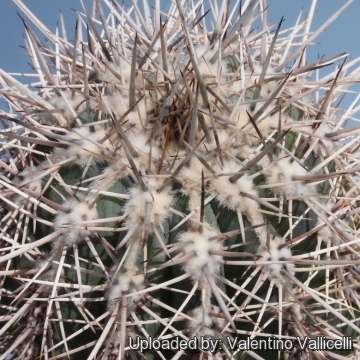
Pilocereus pringlei (Pachycereus pringlei) Photo by: Valentino Vallicelli
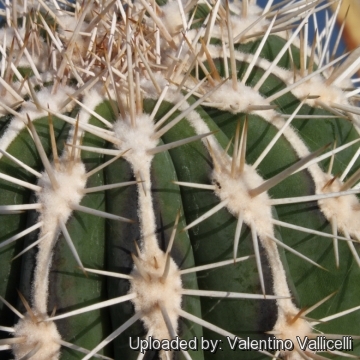
Pilocereus pringlei (Pachycereus pringlei) Photo by: Valentino Vallicelli
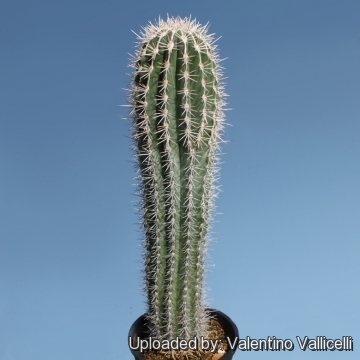
Pilocereus pringlei (Pachycereus pringlei) Photo by: Valentino Vallicelli
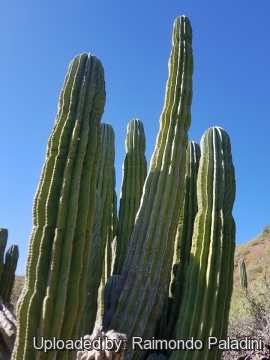
Pilocereus pringlei (Pachycereus pringlei) Photo by: Raimondo Paladini
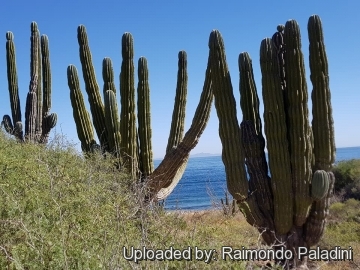
Pilocereus pringlei (Pachycereus pringlei) Photo by: Raimondo Paladini
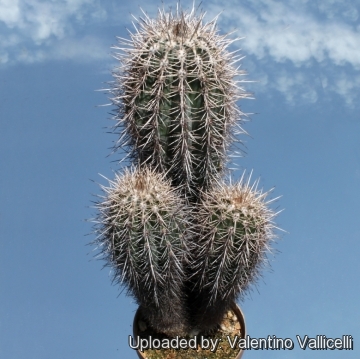
Pilocereus pringlei (Pachycereus pringlei) Photo by: Valentino Vallicelli
Cultivation and Propagation: It is a fairly easy plant to grow. During the summer it is best to keep the plants outside where the temperature can rise to over 30 C with no harm to the plant. Furnish good drainage and use a an open and free draining mineral compost that allows therefore roots to breath. They like only a short winter's rest and should be kept almost completely dry during the winter months, If the soil is allowed to be dry for too long root loss could follow but equally the same result would occur if the plants are both wet and cold. From March onwards the plant will begin to grow and watering should be increased gradually until late May when the plant should be in full growth.
Water regularly during the summer so long as the plant pot is allowed to drain and not sit in a tray of water. During hot weather you may need to water the plants more frequently so long as the plant is actively growing. From late September watering should be reduced to force the plant to go in to a state of semi dormancy, by October you should be back in to the winter watering regime.
Need full sun avoiding only the harshest summer sun, if kept too dark they may become overly lush and greener and could be prone to rotting due to over watering.
Feeding may not be necessary at all if the compost is fresh then, feed in summer only if the plant hasn't been repotted recently. Do not feed the plants from September onwards as this can cause lush growth which can be fatal during the darker cold months. Grown specimens resist to -4°C for a short time, but it is best to keep above 0° C to avoid ugly spots on the plant epidermis.
Traditional uses: Fruits of Pachycereus pringleiSN|8572]]SN|8572]] are harvested by the Seri, they have a slight molasses flavour and are eaten raw or made into a refreshing drink. The seeds are eaten slightly browned or made into flour. The pulp of ripe fruits mixed with pulp of unripe fruits and kneaded into a mass which is made into cakes and dried. The pulpy stem can also be chopped for emergency stock feed and reliable source of emergency water. Stems are also used medicinally. The flesh of this cactus contains alkaloids, and may have been used as a psychoactive plant in Mexico. The trunk was used in hut constructions. Containers have been fashioned from portions of stems that react to woodpecker holes.
Propagation: By seeds or stem cuttings from adult plants.
| Your Actions | |
|---|---|
| Back to Pilocereus index | |
| Back to Cactaceae index | |
 |
Back to Cacti Encyclopedia index |
Privacy stantement - Terms and conditions - How to cite - About us - Feedback - Donate





